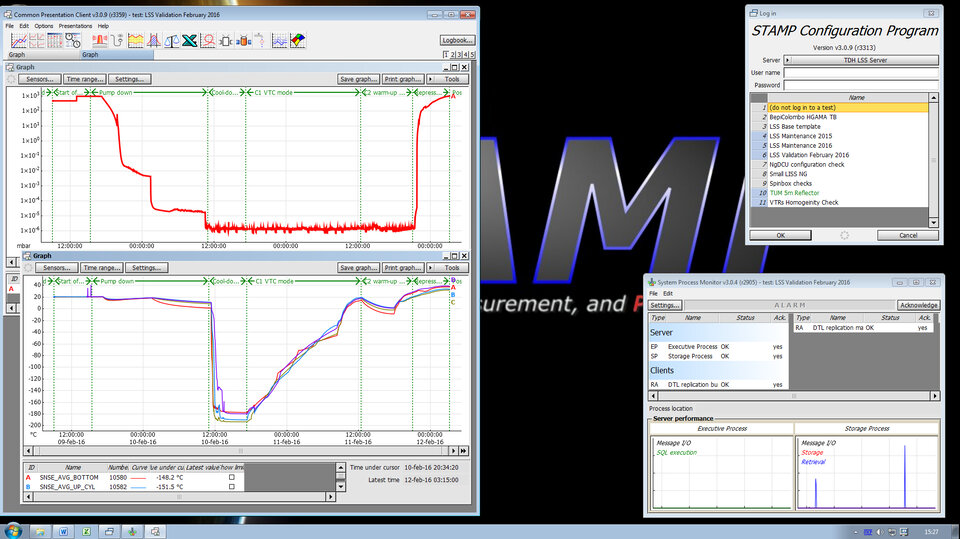Thermal Data Handling Facilities
What are they for?
A range of thermal tests are carried out to assess the satellite's thermal reaction to the space environment. The Thermal Data Handling facilities provide a set of excellent tools of monitor, record and analyse the thermal response of satellites and their payloads during testing.
What kind of testing do they support?
The facilities gather data for several types of thermal testing:
- Thermal balance tests – Satellites incorporate a thermal design subsystem to maintain a fixed temperature range in space conditions. Designers seek to strike an optimal 'thermal balance' between the heat of the Sun, the cold of space and the heat produced by payload electronics. Thermal balance testing subjects the spacecraft to space conditions to see if the temperature of the structure and component subsystems behaves as the thermal designers have modelled.
- Thermal vacuum tests – These involves subjecting the satellite or components to representative vacuum, cryogenic temperature and solar illumination conditions for prolonged periods of time, often several weeks. It typically incorporates 'thermal cycling' where the satellite's response to the rapid temperature shifts caused by rapid transit between sunlight and shadow.
- Infrared radiation tests – The satellite is subjected to infrared radiation from heaters to simulate the heat flux through its structure – how it absorbs and re-emits heat.
- Photogrammetry measurements – Thermal stress can induce harmful structural deformation in satellite structures and crucial subystems such as antennas and reflectors. Very high-precision optical cameras are used to monitor any change in the position of targets attached to the test subject.
The Thermal Data Handling system can gather data for several test facilities at the same time.
What are their features?

The facilities record all the parameters from the test chamber as well as the thermal instrumentation installed on the test specimen. Scanners are available to record the most common type of signals used during thermal tests such as thermocouples, platinum sensors and voltage output sensors.
The reliability of the data handling system is assured by a dual sensor management system, a high degree of redundancy in peripheral equipment and the continuous monitoring of tasks under software control.
The safety of test subjects is assured by the generation of messages and alarm signals when sensor- or derived values exceed pre-set limits or slopes.
The different signals interface to a unique ESA-developed software called STAMP (System for Thermal Analysis, Measurement and Power supply control) able to support thousands of sensors and hundreds of different power supplies used in thermal tests, processing and presenting the acquired data in real time.
What benefits do they deliver?
The Thermal Data Handling facilities linked to the STAMP software system deliver:
- Extreme flexibility – Each test requires a unique set of data acquisition, reduction and presentation capabilities. STAMP can accept almost any specifications for test configurations and requirements and, if necessary, alter them at the last minute or even during the tests themselves.
- Data acquisition – Automated data acquisition from different types of scanner enables versatile acquisition and measurement. If needed, 'raw' values acquired from the sensors can be processed and converted using formulae into meaningful engineering values. Engineers can use formulae to derive new sensor values from those acquired from real measurements. Such a sensor is called a 'virtual sensor'. The real scanners are periodically scanned according to a defined frequency. A typical scan period is 120 seconds for thermal measurements and 30 seconds for power supply control.
- Data presentations – The data can be presented in several forms locally or remotely through a secure server. This allows the sharing of data with specialists not present on site as the test proceeds.
For more information
Please contact Gaetan Piret, ESTEC Test Centre Manager.
Gaetan.Piret @ esa.int




